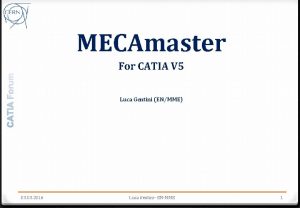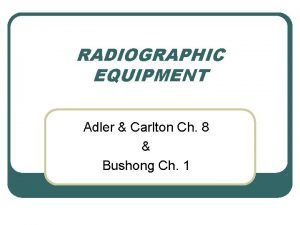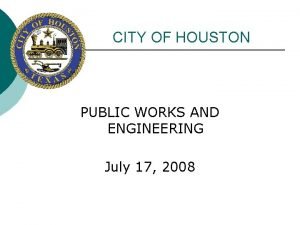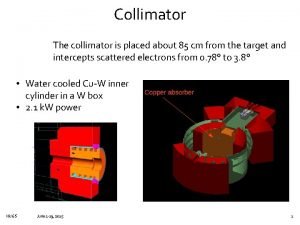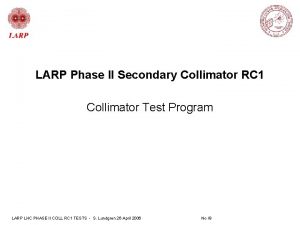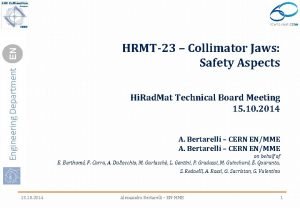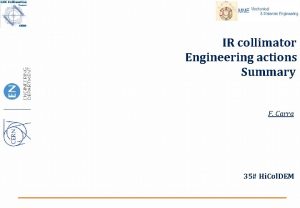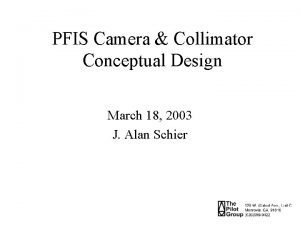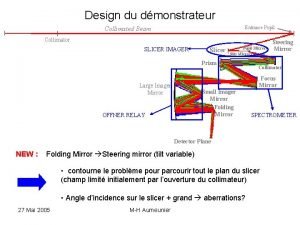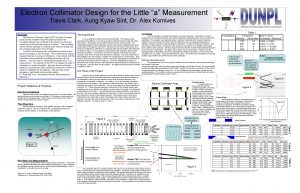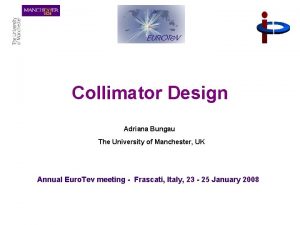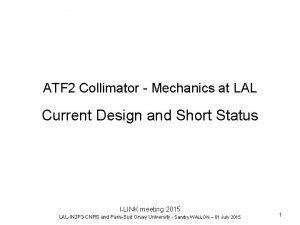Engineering Department EN TCTW Collimator Design L Gentini














- Slides: 14

Engineering Department EN TCTW Collimator Design L. Gentini, A. Bertarelli, M. Garlasche, F. Carra LHC Collimation Working Group 11 April 2016 L. Gentini – CERN (EN-MME)

Engineering Department EN Outlook § Introduction § Design highlights § Testing § Summary 11 April 2016 L. Gentini – CERN (EN-MME) 2

Engineering Department EN Introduction § Challenge: Embed an electric wire in a TCTP collimator jaw to compensate longrange Beam-Beam effects § Requirements: § High DC current (up to 350 A) § Thin wire (ØCU≤ 2. 5 mm) § In-jaw wire (depth ≤ 3 mm) § Maintain TCTP complete functionality! 11 April 2016 L. Gentini – CERN (EN-MME) 3

Wire-Embedded TCTW Cooling pipes Cu. Ni 10 Engineering Department EN Vacuum tank Tungsten inserts (Inermet® IT 180) Jaws BBLRC wire Glidcop “T” support Glidcop Al-15 housing and back stiffener BPM button housing Actuation system 11 April 2016 L. Gentini – CERN (EN-MME) 4

Wire-Embedded TCTW Engineering Department EN § Wire is brazed to a Glidcop “T shape” support § Tungsten block and “T” support connected in series with the housing via screws § Brazing maximizes wire cooling § Increase of diameter where the wire is not in direct contact with the jaw (extremities) § Also clamped to cooling pipes when it’s not in the jaw Thicker wire Cable Dimensions: Transition 30° 0. 3 mm ø 2. 48 mm Mg. O 0. 41 mm Mg. O Cu Cu ø 3. 45 mm 0. 26 mm 0. 365 mm 316 L Note gap between wire and tungsten (0. 1÷ 0. 2 mm) 11 April 2016 Total diameter inside the jaw: ø 3. 6 mm L. Gentini – CERN (EN-MME) 316 L Total diameter outside the jaw: ø 5 mm 5

Engineering Department EN Jaw Assembling 2. 3. 1. 11 April 2016 L. Gentini – CERN (EN-MME) Brazing of Final assembly cable / tightening cable/insert cup / cable cooling system / sockets 6

Engineering Department EN “T” support manufacturing CINEL procedure CERN procedure 1. Machining the “T” support to the final dimensions 1. Machining the “T” support with over material 2. Brazing (All deformation due to the brazing thermal treatment will be restrained tightening the W blocks after assembly) 3. Re-machining of the piece to the final dimensions 11 April 2016 L. Gentini – CERN (EN-MME) 7

Brazing tests at CERN Engineering Department EN Wire / housing / cooling clamp / cup with hold configuration (No “T” support) RESULTS - Very good visual results on the straight part of the wire, on the cooling clamp and on the cup. Some areas without brazing material on the extremity radius. - X Ray: results seem good, although not easy interpretation because there was not enough access. - Dimensional test have been done after the two different brazing thermal treatments. No relevant deformations were detected. 11 April 2016 L. Gentini – CERN (EN-MME) 8

Brazing tests Wire / “T” shape Engineering Department EN 4 “T” shape has been Brazed: - 2 at CERN (one in Glidcop and one in Copper OFE) - 2 at CINEL (one in Glidcop and one in Copper OFE) Metrology Results CERN Good results under load CINEL Good results 11 April 2016 L. Gentini – CERN (EN-MME) 9

Micro-tomography Engineering Department EN Unrolled demi-cylindrical surface at the brazing joint 11 April 2016 L. Gentini – CERN (EN-MME) 10

Microscope inspection Engineering Department EN Dark areas represent a thin layer of brazing material porosities 11 April 2016 L. Gentini – CERN (EN-MME) 11

Electrical tests Engineering Department EN § After several bending cycles, the electrical performance of the cables is unchanged. BPM cables tooling § After brazing thermal treatment, the electrical performance of cables is unchanged. NO influence on electrical resistivity 11 April 2016 L. Gentini – CERN (EN-MME) √ 12

Summary Engineering Department EN § The TCTW maintains the complete functionality of a standard TCTP • Numerical calculations and experimental tests show that the TCTW accepts the same load scenarios of a TCTP without losing in safety (for more details on the simulations, see F. Carra’s talk at the workshop in Lyon in November 2015) • Extensive R&D done on further aspects of BBLRC installation: bake-out compatibility, impedance and beam cleaning analyses § Evacuation of the very high heat load generated by joule effect is done brazing the wire to a “T” shape insert (1 k. W on the wire only – higher than the design load of a full TCTP jaw!) § The minimum thickness of the Inermet jaw has been defined in 1 mm, to take into account possible accidental loads coming during transport and manipulation of the blocks, and to ease machining § Some open points to be analysed: radiation effects on the insulator, vacuum tests, wire influence on BPM measurement, electrical acceptance tests, … 11 April 2016 L. Gentini – CERN (EN-MME) 13

Engineering Department EN Thank you for your attention 11 April 2016 L. Gentini – CERN (EN-MME) 14
 Luca gentini
Luca gentini Collimator types
Collimator types Collimator of x ray tube
Collimator of x ray tube Collimator types
Collimator types Collimator
Collimator Collimator
Collimator Electrical engineering department
Electrical engineering department Engineering department in hotel
Engineering department in hotel City of houston engineering department
City of houston engineering department Kpi for engineering department
Kpi for engineering department Department of information engineering university of padova
Department of information engineering university of padova Information engineering padova
Information engineering padova Tum department of electrical and computer engineering
Tum department of electrical and computer engineering Iit delhi polymer science
Iit delhi polymer science University of bridgeport engineering
University of bridgeport engineering
